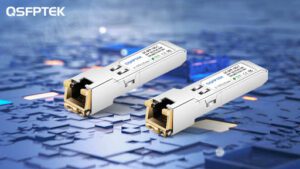Introduction to 10GBASE-T Copper Module
10GBASE-T is a network protocol that is used to connect devices on a computer network. It was developed in 2003 and was later released in 2005.
10GBASE-T is an Ethernet standard that operates at 10 gigabits per second (Gbps). The “T” stands for Twisted Pair, which means that signals are transmitted over copper wire pairs. This type of connection is more reliable than using optical fiber or coaxial cable, but it can be difficult to install because the wires need to be run through walls and ceilings.
The 10GBASE-T standard specifies how fast data can be transferred between two devices on an Ethernet network. With 10GBASE-T, data can be transferred at speeds of up to 10 gigabits per second (Gbps).
10GBASE-T is a network technology that provides 10 Gbit/s speed. It was initially designed for backbone and high-speed LAN (Local Area Network) connections. The standard specifies a maximum length of 100 meters, but it can also be used as a point-to-point connection between two devices.
10GBASE-T is an Ethernet standard that provides 10 Gbit/s speed on twisted pair cabling using the baseband transmission method. 10GBASE-Tis compatible with existing standards such as 100BASE-TX and 1000BASE-T and uses the same RJ45 connectors.
10GBASE-T Copper Module in your Network
10GBASE-T is a type of Ethernet connection that can provide speeds up to 10 gigabits per second. The acronym stands for 10 Gigabit Base-T, which means the technology uses baseband signalling on UTP (unshielded twisted pair) cables.
Gigabit Ethernet is an old type of Ethernet connection with speeds up to 1000 megabits per second, while 10 gigabit Ethernet provides speeds up to 10000 megabits per second. The main difference between these two types of connections is the number of bits they use in each packet – 8 bits for gigabit and 128 bits for 10 gigabits.
10GBASE-T is a standard for Ethernet over twisted-pair cables. It can be used to transmit data at 10 gigabits per second, which is 10 times faster than the older standard, 100BASE-T.
In order to achieve this speed, 10GBASE-Tuses four pairs of wires in parallel. This doubles the maximum length of a cable that can be used and reduces the number of connectors needed.
What are the Benefits of Using a 10GBASE-T Network?
The 10GBASE-Tcopper module is a cost-effective solution for the 10 Gigabit Ethernet networks. There are many advantages of using 10GBASE-Tcopper modules. One of them is that it is cost-effective. Copper modules are much cheaper than optical modules and can be used to connect the network devices, such as servers and switches. They also have a smaller footprint which means that they can be installed in tight spaces easily.
10GBASE-Tcopper modules are a cost-effective solution for short-distance high-speed data transfers. The advantages of the 10GBASE-Tcopper module are:
1) A 10GBASE-Tcopper module is less expensive than a 10G optical module.
2) The installation and maintenance of 10GBASE-Tcopper modules are easy.
3) 10GBASE-T copper modules can be used to connect two Ethernet devices without any additional equipment.
4) The bandwidth of the 10GBASE-Tcopper module is higher than that of the 100BASE-TX and 1000BASE-TX standards, which makes it suitable for connecting servers in a data center or enterprise network.

Conclusion
This article describes what 10GBASE-T copper modules are. 10GBASE-Tcopper modules can run 10G Ethernet over existing infrastructure at a very low cost, which brings a lot of convenience to data centers, and with 10GBASE-Tmodules, many small data centers can have 10G rates. If you would like to know more about the 10GBASE-Tcopper module, please contact QSFPTEK via sales@qsfptek.com. We offer a wide range of high-quality, cost-effective optical modules, and optical module-related products.
